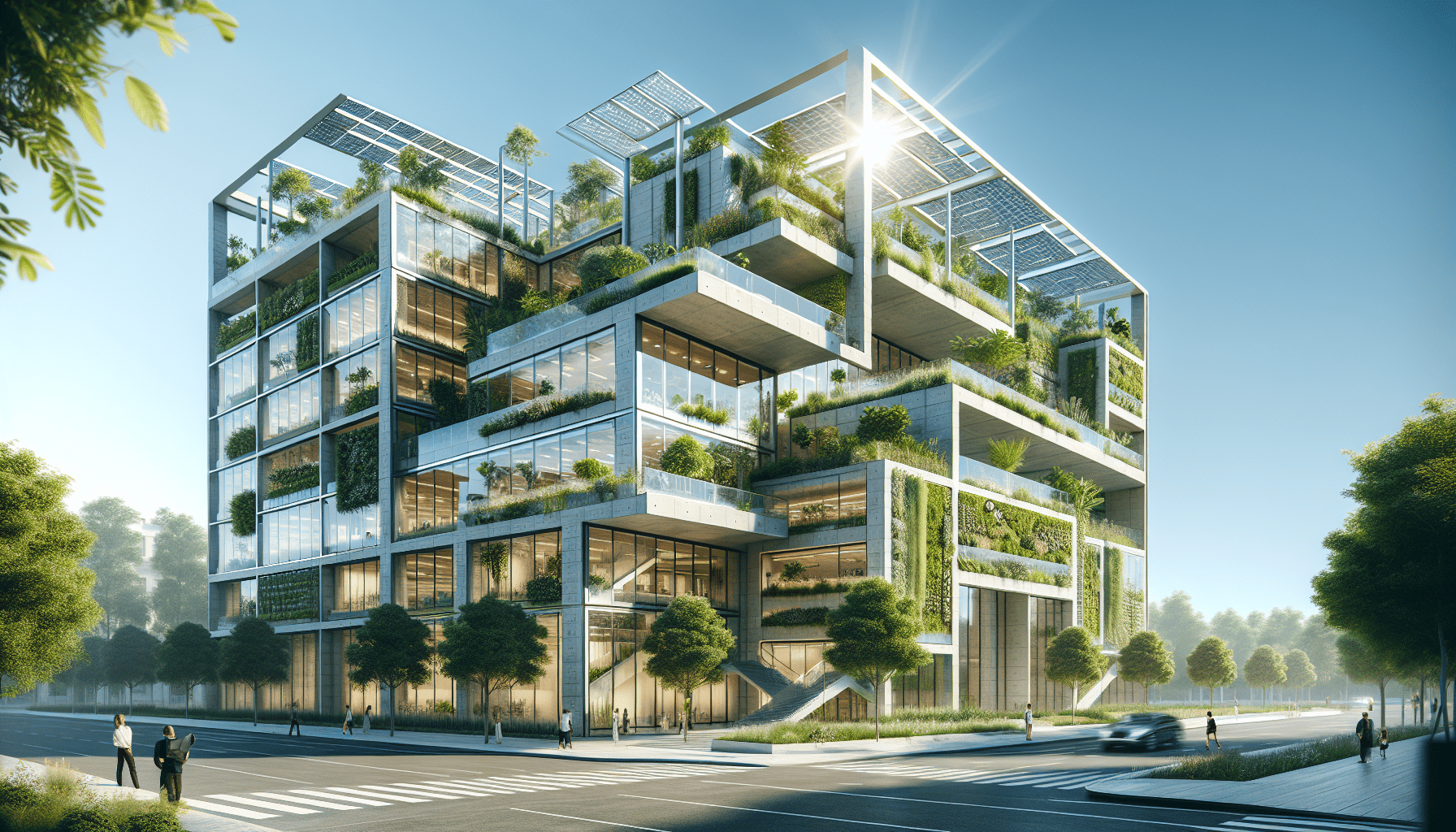Let’s dive into the world of sustainable architecture and discover what LEED certification is all about. LEED, which stands for Leadership in Energy and Environmental Design, is a globally recognized certification system that sets the standard for eco-friendly building practices. When we explore the intricacies of LEED certification, we uncover how it promotes energy efficiency, reduces carbon footprints, and enhances overall environmental quality. This system not only benefits the planet but also improves the well-being of the occupants, fostering a healthier and more sustainable way of living and working in our built environments. Have you ever wondered what makes a building truly sustainable? In the world of architecture and construction, one of the gold standards for measuring sustainability is LEED certification. We often hear about green buildings and eco-friendly designs, but what does it all really mean? Let’s dive deep into the concept of LEED certification and its significance in sustainable architecture.
What is LEED Certification?
LEED, which stands for Leadership in Energy and Environmental Design, is an internationally recognized green building certification system. It was developed by the U.S. Green Building Council (USGBC) to provide a framework for healthy, highly efficient, and cost-saving green buildings. By using LEED, we can create and manage structures that are environmentally responsible from inception to operation.
The Origin of LEED
LEED began in 1998 with the goal of transforming the way buildings and communities are designed, constructed, and operated. It has since grown into a comprehensive toolkit that helps us incorporate sustainable practices across various building types and projects. The system has evolved to address different regions, building types, and developmental phases.
How LEED Certification Works
Buildings earn LEED points across several categories, such as energy use, water management, air quality, and materials. These points determine the level of certification the project will achieve:
| Certification Level | Points Range |
|---|---|
| Certified | 40–49 points |
| Silver | 50–59 points |
| Gold | 60–79 points |
| Platinum | 80 points and above |
Projects can choose the areas where they want to gain points to appeal to specific sustainability goals.
Categories of LEED Certification
LEED certification isn’t one-size-fits-all; it covers various aspects of building design, construction, and operation. Here’s a breakdown of key categories:
Location and Transportation
This category encourages us to choose project sites that promote sustainable transportation options like public transit, walking, and biking. It also emphasizes the importance of developing on previously developed land, reducing urban sprawl, and increasing the efficiency of land use.
Sustainable Sites
Sustainable Sites focus on the ecological aspects of the land a building occupies. Points in this category can be earned by minimizing impact on ecosystems and water resources. This includes everything from managing stormwater to reducing the heat island effect caused by non-reflective materials.
Water Efficiency
In a world where water scarcity is becoming more prominent, optimizing water use is crucial. This category measures efficiency inside and outside the building, from fixtures that use less water to landscape designs that require minimal irrigation.
Energy and Atmosphere
Energy and Atmosphere is perhaps one of the most critical categories. It focuses on both the energy performance of a building and the sources of energy. Reducing energy consumption, enhancing energy performance, and using renewable energy sources are key objectives.
Materials and Resources
This category is about the selection and management of building materials. Using recycled or sustainably sourced materials, managing waste during construction, and ensuring responsible sourcing are ways we can earn points here.
Indoor Environmental Quality
The quality of the indoor environment influences the comfort and health of the building’s occupants. Points in this category are awarded for improving air quality, access to daylight, acoustic performance, and control over individual lighting and thermal settings.
Innovation and Design
This category allows for creative solutions that go beyond the standard LEED requirements. We can earn points for innovative approaches to sustainability, including exemplary performance in other LEED categories or the introduction of new technologies and strategies.
Regional Priority
Some environmental issues are more critical in certain locales. Regional Priority points are awarded for addressing problems specific to a project’s regional context, thus encouraging solutions that are highly relevant.

Why LEED Certification is Important
The significance of LEED certification goes beyond just having a green building badge. It brings numerous benefits:
Environmental Impact
One of the most significant advantages of LEED certification is the positive impact on the environment. By adhering to its standards, we help reduce greenhouse gas emissions, conserve water, and reduce waste. Every LEED-certified building is a step towards a healthier planet.
Economic Benefits
Though the initial investment for a LEED-certified project can be higher, the economic benefits are substantial in the long run. Energy and water savings, reduced maintenance costs, and higher building values can lead to significant financial gains.
Health and Well-being
As buildings become greener, they also become healthier for us to live and work in. Improved air quality, natural light, and good acoustics can make a significant difference in occupant well-being and productivity.
Community Benefits
LEED-certified buildings also contribute to the well-being of the larger community. Reduced strain on local infrastructure, better waste management, and improved quality of life for residents are just some of the benefits that extend beyond the physical building.
The Process of Getting LEED Certified
Achieving LEED certification is a structured process that involves multiple steps, starting from initial planning through to final verification.
Pre-certification
Pre-certification can be an optional step, but it helps us understand the potential level of certification early in the project, often during the design phase. It serves as a roadmap to guide more specific decisions along the way.
Registering the Project
Before we can start collecting points, the project must be registered with the USGBC. The registration involves submitting basic project details and paying a fee.
Choosing Credits
Based on the project’s goals, we select the credits we’ll aim to achieve. This decision-making process involves balancing various sustainability priorities while staying within the budget.
Documenting and Submitting
After the design and construction phases, we compile all necessary documentation to prove compliance with the chosen credits. This documentation is then submitted for review.
Certification Review
The submitted documents undergo a rigorous review process where each credit is evaluated. Based on the review, the project is awarded points and assigned a certification level (Certified, Silver, Gold, or Platinum).
Re-certification
LEED certification isn’t a once-and-done achievement. Some projects, especially those under LEED for existing buildings, require re-certification over time to maintain their status.

LEED Rating Systems
LEED certification can be applied to a diverse range of projects. Different rating systems have been developed to meet the needs of various building types.
LEED for Building Design and Construction (BD+C)
This rating system is designed for new buildings or major renovations. It covers a variety of project types, including commercial, residential, retail, and schools.
LEED for Interior Design and Construction (ID+C)
ID+C is tailored for interior spaces under the control of tenants or occupants. This is commonly used for commercial interiors, retail spaces, and hospitality projects.
LEED for Building Operations and Maintenance (O+M)
For existing buildings that are being retrofitted or upgraded, the O+M rating system ensures ongoing sustainable operations. This is suitable for a wide range of existing building types.
LEED for Neighborhood Development (ND)
LEED ND focuses on larger-scale projects that integrate buildings with their surroundings, encouraging sustainability at the community level. This might include urban development projects, residential neighborhoods, or mixed-use communities.
LEED for Homes
This rating system focuses specifically on residential buildings, whether single-family or multi-family units. It addresses aspects unique to home building, such as the use of energy-efficient appliances, water-saving fixtures, and healthy indoor environments.
Global Influence of LEED
While LEED originated in the United States, its principles are applicable worldwide. There are LEED projects in over 165 countries, demonstrating its global reach and adaptability to different regional contexts.
International Recognition
Many countries have embraced LEED certification as a benchmark for sustainable construction. This international recognition helps create a global standard for green buildings, making it easier for us to work across borders with consistent sustainability goals.
Adaptations for Local Context
To ensure relevance in various countries, local adaptations of the LEED rating systems are sometimes created. These adaptations account for regional environmental priorities, building practices, and regulatory requirements.

Challenges in Achieving LEED Certification
While LEED certification is immensely beneficial, it also comes with its set of challenges. Understanding these can help us better prepare for the certification process.
Cost Implications
The process of earning LEED certification can be costly, ranging from registration fees to the expense of implementing sustainable technologies. It requires us to make a careful cost-benefit analysis to ensure long-term returns on investment.
Documentation and Verification
The rigorous documentation and verification process can be time-consuming and complex. Ensuring that all credits are adequately documented requires meticulous planning and attention to detail.
Balancing Trade-offs
Sometimes, achieving one LEED credit may come at the expense of another. Balancing these trade-offs requires strategic planning and a comprehensive understanding of the project’s overall sustainability goals.
Success Stories in LEED Certification
To truly understand the impact of LEED, it’s helpful to look at successful examples. Numerous buildings worldwide exemplify the best practices in sustainability thanks to LEED.
The Bank of America Tower, New York
This skyscraper is one of the most sustainable buildings in the world, achieving LEED Platinum certification. Its features include a greywater system, energy-efficient systems, and materials sourced from regional suppliers.
Taipei 101, Taiwan
Once the tallest building in the world, Taipei 101 earned LEED Platinum certification for existing buildings. The tower’s energy-efficient design, waste management systems, and occupant health-focused strategies set a high bar for skyscrapers globally.
Vancouver Convention Centre, Canada
This convention center exemplifies sustainability with its LEED Platinum certification. It includes a six-acre living roof, on-site water treatment, and energy-efficient systems, proving that large commercial spaces can be green too.

The Future of LEED and Sustainable Architecture
As the environmental challenges we face continue to evolve, so does LEED and the field of sustainable architecture.
Updates to LEED
LEED is continually updated to incorporate new technologies, materials, and strategies. The latest versions of the rating systems reflect cutting-edge practices in sustainable design and construction.
Integration with Other Standards
LEED is increasingly being integrated with other building standards and certifications, creating a holistic approach to sustainability. For instance, combining LEED with WELL certification can address both environmental and human health performance.
The Role of Innovation
The future of LEED and sustainable architecture lies in innovation. New building technologies, materials, and construction methods will continue to emerge, and LEED will likely adapt to incorporate these advancements.
Conclusion
LEED certification is more than just a badge of honor. It represents a commitment to sustainability, health, and well-being for both the planet and its inhabitants. By adhering to LEED standards, we can create buildings that are not only environmentally friendly but also economically viable and pleasant to live and work in. As we look to the future, the principles of LEED and sustainable architecture will undoubtedly continue to evolve, setting new benchmarks for what’s possible in green building design. Let’s embrace this journey toward a more sustainable world, one LEED-certified building at a time.